Rakugo and Japanese Language Education
Sankyo Yanagiya (Rakugo Performer)
Sankyo Yanagiya, a rakugo performer, has been active in performing rakugo, which is one of the traditional performing arts of Japan, and teaching kobanashi (short comic story), as part of Japanese language education for many years. In recognition of his contributions to the spread of Japanese culture, both in Japan and overseas and the development of Japanese language education, he was awarded the 2014 Japan Foundation Awards. This was the first time that the Award had been presented to a rakugo performer. We present a part of a lecture given by Sankyo Yanagiya commemorating the receipt of the award, "Rakugo and Japanese Language Education."
(From the lecture and rakugo performance at the JFIC Hall "Sakura" on October 27, 2014)
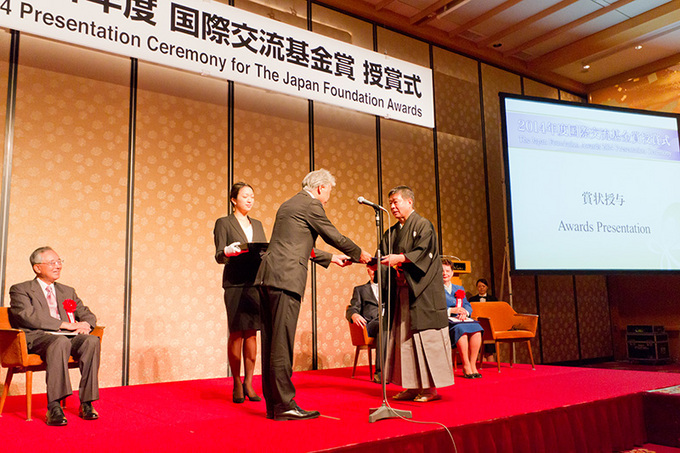

The Awards Ceremony for the 2014 Japan Foundation Awards
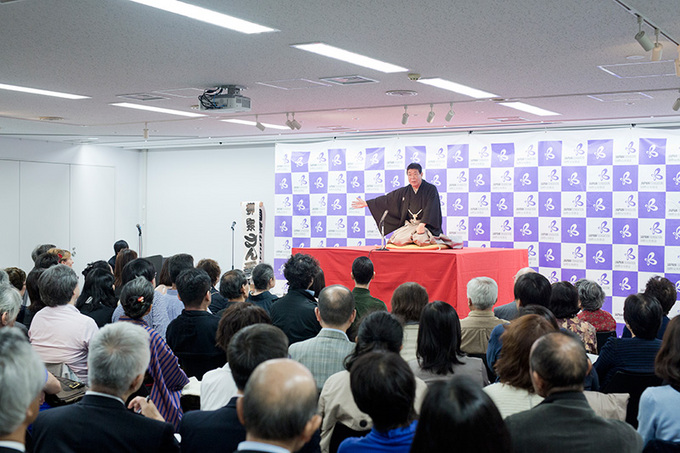
The 2014 Japan Foundation Awards Commemorative Lecture
To Bring Laughter
About 14 years ago, Professor (then Associate Professor) Takako Sakai at Tsukuba University said to me, "I would like to introduce rakugo to our Japanese language education." That was how I came to be involved in Japanese language education. To tell the truth, at the time I did not think it would be possible to make foreign people understand rakugo, and also felt there was no need to do so. I did not see any point in performing rakugo for the purpose of Japanese language education or trying to get people to understand it. But then I thought that could be a way to help Japanese learners, so I made efforts to have people understand Japanese through rakugo performance. However, that was actually not the case.
In any event, rakugo is a Japanese traditional performing art, and you have to have a certain amount of knowledge about Japanese culture. For example, when Japanese people see a fan and a tenugui (a thin hand towel made of cotton), they immediately understand what they are, without any explanation. They would also understand, "he just had a smoke" by a certain gesture, for example. In Japanese, ippuku (having a smoke) means not only smoking a cigarette, but also taking a break. I suddenly realized this, and then I thought, "It is not that I perform rakugo, but I let them use elements of rakugo as materials for studying the Japanese language." This is what made me think that I could help people to study Japanese.
I came to the point of having the students themselves perform rakugo, but then I wondered what kind of rakugo I should have them perform. Some rakugo pieces can last for five or six hours, or even ten hours. So I summarized a few short stories of about fifteen minutes long to three or four minutes each, and put them together on a demo tape that was about ten minutes long. Then I asked the students to memorize it, and they manage to memorize and perform it. However, it did not bring laughter. It is because they did not have techniques to tell the punchlines. Thinking that ten minutes was too hard, I hit upon the idea of having them perform kobanashi. As you know, kobanashi itself is an essence of laughter.
"A priest came from over there."
"Sō kai?" ("Is that so?/A priest?" Sō in Japanese means both "priest" and "so.")
"I am thinking of building a roof here."
"Ya-ne." ("Bad idea/roof." Yane means both "I do not like it" and "roof.")
As these examples above show, it is wordplay. I did not want students to play with words, but did them to memorize kobanashi to learn many things.
There are many kobanashi about thieves, as I mentioned briefly at the award ceremony the other day. I prepared about 30 or 40 kobanashi for the students, and let them choose the ones they want to try. With the help from their teacher, Professor Takako Sakai, I chose some makura (an introductory short story told before starting a main body) from many different books. Almost all stories we chose at the time were kobanashi about thieves that were used as makura in classic rakugo.
The gesture of opening a window while saying, "Hey!" is different in Japan and in Europe. I could sense the cultural differences there. Then I thought that there must be a way to adapt punchlines to their culture. The gesture of opening a window made me realize that non-Japanese could modify kobanashi so that they can express things in their own way. So I told them to do a kobanashi in whatever way they like. I introduced a kobanashi to them, but told them that they did not have to perform it in the same way. They could create one from their own story in Japanese. So I had the students learn it as they wish, and then they performed their story in front of their fellow Japanese language students and other Japanese learners to see if they could make other people understand. As a result, they gradually became able to bring laughter.
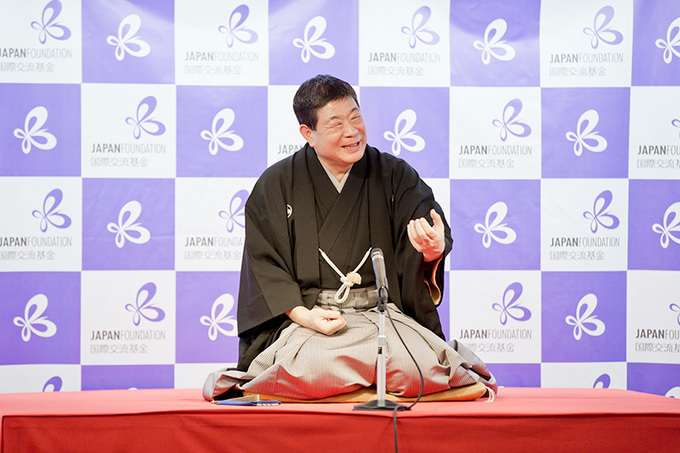
Gestures are a Part of Culture
Professor Kazumi Hatasa, the Director of the Japanese School at Middlebury University in the U.S. (a professor of Japanese at Purdue University, and the Director of the Japanese School Summer Program at Middlebury University), have many students each year for the Japanese classes. Apparently many of those students were first interested in Japanese manga, and then decided to study Japanese. It seems that the number of people who started learning Japanese after having contracted its culture has been increasing.
It was decided that I would assist Professor Hatasa in teaching Japanese. This includes more than having his students learn kobanashi. I performed some rakugo during the classes and interacted with the students. During the classes I always talked about gestures. Gestures reflect Japanese culture. I did not realized that before. For example, when writing something in a notebook, Japanese people write it vertically. Just the act of dipping a brush into sumi ink would be understood by any Japanese person because it is a part of Japanese culture, and every Japanese person would have had experience of doing this at least once. I thought that students would be able to discover Japanese culture through studying gestures. Another example is the gesture of eating soba noodles. In foreign cultures, it is not good to make sounds while eating. However, Japanese people do sometime make a noise when you eat, and I realized this is a part of Japanese culture, too.
I said to a French newspaper journalist, "When I next perform in France, I plan to do Toki Soba. French people probably do not like people slurp, do they? They probably think it seems vulgar, right? But if I perform Toki Soba, I have to make slurping sounds." The reply was, "That is Japanese culture, isn't it? French people do not despise other countries' cultures." If Japanese people go abroad and make a noise when they eat, that is probably bad manners, and not a good idea either. But intelligent French people would say, "Making slurping sounds is the culture of Japan, and French people will not reject that." Talking about such matters broaden my horizon. Up until now, we rakugo performers were nestled in our own little world. However, as we perform for foreigners, have them seeing rakugo, and have them try to perform kobanashi themselves, my world is gradually getting bigger and bigger. This made me realize that I only had a limited perspective as a Japanese person. Through being able to help with the Japanese language education, I have learned a lot myself, and feel grateful that I have discovered new things.
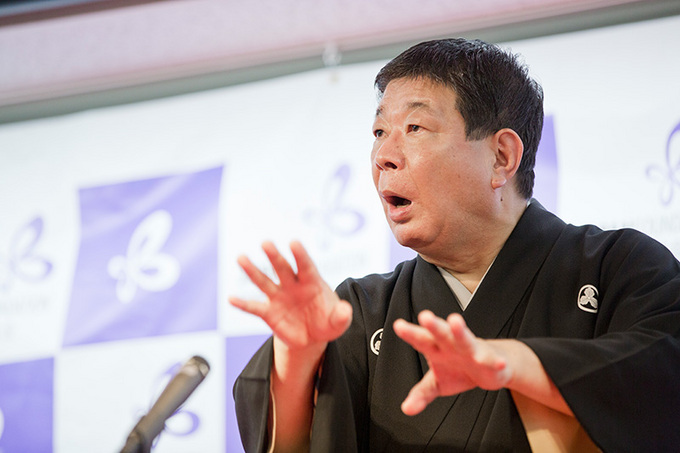
U.S. Students Try performing Kobanashi
We decided to make continuations of a story called Zoro Zoro (an onomatopoeia to describe a situation when people go somewhere in droves. For the scenario, see the note at the end of this article.) The students were devided into groups of four or five and created a comic story in Japanese titled Zoro Zoro. This means they were not thinking in their own mother language, but trying to express them in Japanese in a comical way. It took some time to get to that stage but they managed to create some kobanashi. The following story about a manju (steamed bun) shop is what some of the U.S. students came up with:
The activity has been developed from creating a story in Japanese and laughing at its punchline to giving the story another twist. It was very enjoyable and I felt that there were plenty more possibilities still to come.
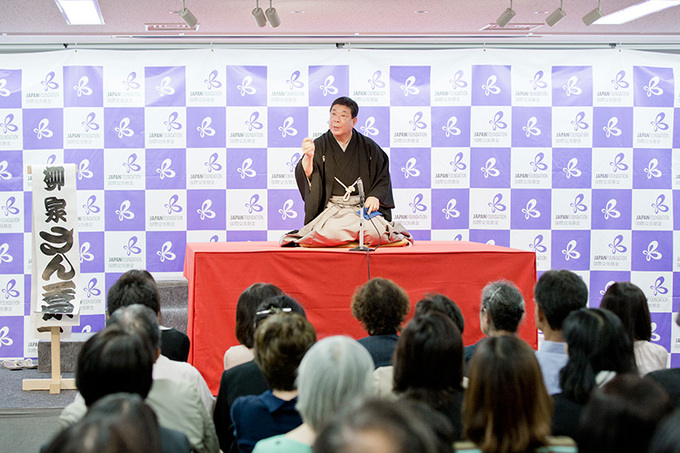
Developing a Sense of Solidarity through the Japanese Language
Now I have come to think about how rakugo can be used in Japanese language study, and how rakugo can be incorporated into teaching materials. I know rakugo is not the main topic and started thinking about how to use raukgo as the reference or study materials. This enabled me to grasp the culture, which all Japanese people know and have experienced, with language learners and to give variety to lessons thanks to rakugo. On top of it, I feel a sense of solidarity.
One time I performed Shibahama in front of students who understand Japanese. I thought that only Japanese people could understand the emotion written in the story, but tried performing it anyway. The story is about love between a married couple, and made the audience cry, just like it makes Japanese people cry. Then I realized that people share the same emotions across countries. Regardless of nationality, we all have emotions: laughter, anger, and affection. Being human beings, we all have these feelings. The audience listened to human interest stories in the same way a Japanese person would. When I performed Shibahama, one student came up to me and said, "Master, I could see the sea!" I felt speechless and touched beyond words. I imagine the sea that student saw was not the sea in the story. I have never seen it myself. What everyone visualizes is, I think, seas drawn in nishiki-e (colored woodblock print) or appeared in period dramas. Of course no one here actually saw Shibahama before it was impoldered in the Edo period. Therefore, the sea in each person's mind can be Shibahama. For that student, Shibahama might have been a sea in his memory. Or it might have been the scenery of Japanese beach that he came across through studying Japanese. Whatever it might have been, when I imagine he saw the sea and was able to visualize Katsugoro looking at the sea, I came to realize that rakugo, including abundant emotions of Japanese people, can be understood by anybody. This can surely be a great help for understanding Japanese culture.
The students repeated practice the kobanashi and were given chances to perform it. There were from seven or eight to fifteen performers at one time. I always feel sorry for the person who performs first, because he or she must be feeling like being tested. Even if I tell them not to worry, they get really nervous. Then I pat them on the back and they calm down. Once I said, "In Japan, patting someone's back make him feel calm," and this spread among my students without realizing it. Now, wherever I go, students say, "Master, pat my back!" and turn their back towards me.
The way we start our performance by a kobanashi is loved by audience. If they laugh, the students waiting in the wings do a victory pose. There is a feeling of solidarity arising among the students through their study. When I see this I feel really happy, and sometimes it even makes me cry. What I can do is only a very small thing, but thanks to the Japanese language teachers overseas and volunteers who support me, I have been able to have people study Japanese and to help their study through rakugo for fourteen or fifteen years now. Such thoughts flash through my mind.
I am still thinking about possibilities how I, as a rakugo performer, can help people study Japanese. I would be honored if I could continue doing it in various way from now on.
Synopsis of Zoro Zoro
Taro Inari shrine is in the middle of the rice fields of Asakusa. On the path approaching the shrine, there is just one shop, a tea shop-cum-general goods store. The shop owner always goes to the shrine to worship. There had been few customers lately, but when it started raining a customer, who was sheltering from the rain, bought a pair of waraji straw sandals as he thought it would be easier to walk in the rain with them. This was the shop's first sale of waraji in three years. The next customer also wanted a pair. After a while all pairs were sold and the shop ran out of stock.
When a new customer came in and the owner told him he had sold out waraji, but a pair of waraji suddenly hung down from the ceiling. Even though the owner did not understand what had happened, he sold the pair. Then the next pair of waraji came down from the ceiling, and they kept on coming, from one to the next. This kept happening, and his business became thriving by selling a lot of waraji. People rumored it must have been blessing from the Inari shrine. As the rumor spread, many people came to visit the shrine.
A barber in Tamachi heard about this and followed the shop's example by going to the Taro Inari shrine himself. He prayed, "Please give me your blessing, just like you did to the teashop owner." The barber's wish came true. When he got back to his shop, where he had hardly any customers, there were too many people that he could hardly get inside. Making his way through all the customers to get into the shop, the barber put his first customer in a chair. "Sorry to keep you waiting. What can I do for you?" "Please shave my beard." "Of course, just leave it up to me." Saying so, the barber started shaving the customer with his valued razor. But a new beard just kept on growing on the customer, without stopping!
Reference: Walking the Setting of Zoro-zoro
http://ginjo.fc2web.com/011zorozoro/zorozoro.htm
(Photos at the lecture taken by Kenichi Aikawa)
Back Issues
- 2023.12. 7 Movie Theaters aroun…
- 2023.6.16 The 49th Japan Found…
- 2023.4.24 The 49th Japan Found…
- 2022.12.27 Living Together with…
- 2022.12.27 Living Together with…
- 2022.8.12 Inner Diversity <…
- 2022.3.31 The 48th Japan Found…
- 2022.3.29 Beyond Disasters - T…
- 2021.11.29 Crossing Borders, En…
- 2021.4.13 Crossing Borders, En…

